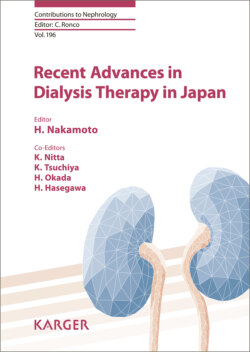Читать книгу Recent Advances in Dialysis Therapy in Japan - Группа авторов - Страница 101
На сайте Литреса книга снята с продажи.
Results
ОглавлениеThe demographic and clinical characteristics of the 148 patients are shown in Table 1. The mean dialysis duration was 100.9 ± 90.2 months. Of these patients, 141 (95.3%) were treated with an erythropoiesis-stimulating agent, 38 (25.7%) with a renin-angiotensin system inhibitor, 54 (36.5%) with cinacalcet, and 124 (83.8%) with a VDRA. The latter included 23 (15.5%) patients who received an oral VDRA and 105 (70.9%) who received i.v. maxacalcitol. The mean log serum FGF23 level was 3.7 ± 0.8 pg/mL. When the patients were classified into two groups according to their median serum log FGF23 levels (<3.82 and ≥3.82 pg/mL), the two groups differed significantly in SBP, hemoglobin concentration, serum concentrations of corrected Ca, P, and alkaline phosphatase, and oral or i.v. maxacalcitol (Table 2). Serum log FGF23 levels were significantly higher in the i.v. maxacalcitol-administered group than in the no VDRA (Fig. 1a). The amounts of serum FGF23 concentrations had been significantly higher to the amount of i.v. maxacalcitol per week dependency in a linear regression (r = 0.33, p < 0.01) (Fig. 1b). Univariate analysis showed that SBP, hemoglobin concentration, serum concentrations of corrected Ca, P, alkaline phosphatase, and i.v. maxacalcitol were significantly correlated with serum log FGF23 level. Multivariate regression analysis showed that I.V. maxacalcitol administration (p < 0.01), as well as serum-corrected Ca and P concentrations, were independently correlated with serum log FGF23 level (Table 3).
Table 2. Clinical characteristics and treatment of patients above and below median serum log fibroblast growth factor 23 level
Fig. 1. a Comparison of serum fibroblast growth factor 23 (FGF23) concentrations between the treatments with vitamin D receptor activator (VDRA). * p < 0.01 vs. no VDRA. b Correlation between serum FGF23 and the amounts of i.v. maxacalcitol per week.
